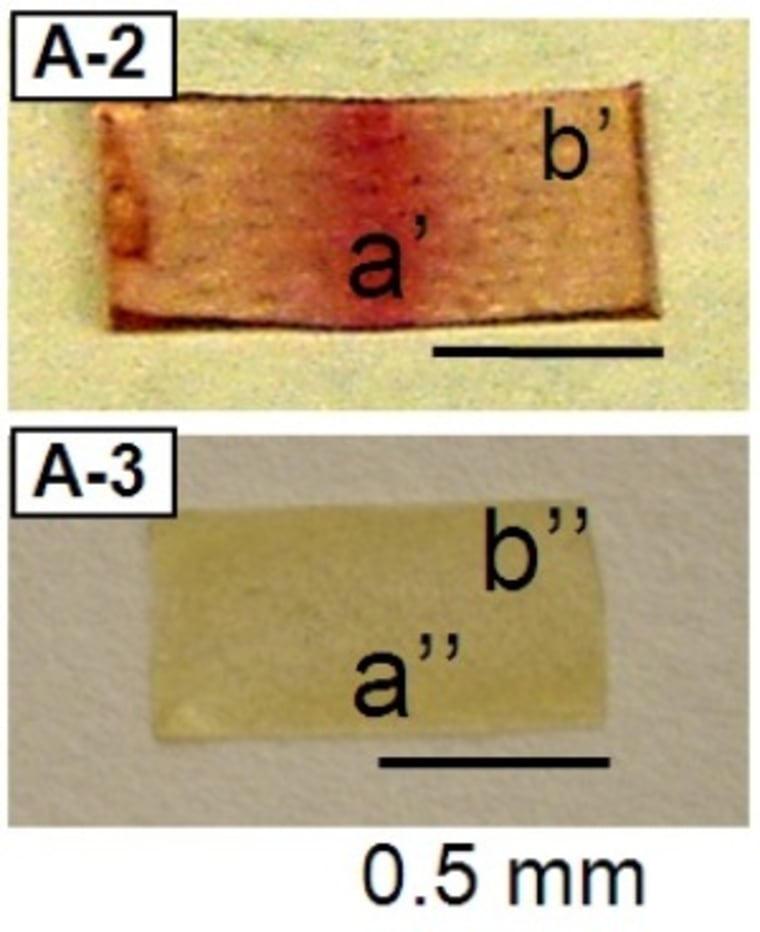Scientists are creeping closer to the creation of self-healing plastics full of sci-fi features that would be ideal for everything from airplanes that fix themselves in flight to cars whose parking-lot scratches disappear by the end of the day.
In one of the latest developments, researchers are reporting a material that changes color when compromised and then self-heals in response to light or other stimuli.
While many of the details are industry-guarded secrets, each step forward brings companies closer to creating a new generation of products that retain their integrity indefinitely.
NEWS: Plastic Heal Thyself: Scientists Invent Smart Polymers
“There are millions and millions of applications, ranging from transportation to sensing to space to energy to cosmetics to health to medicine to many things,” said Marek Urban, a polymer scientist at the University of Southern Mississippi in Hattiesburg, who presented some of his latest work today at a the American Chemical Society meeting in San Diego. “Whatever you desire.”
One of the first major breakthroughs in self-healing materials came in 2001, when researchers at the University of Illinois at Urbana-Champaign figured out how to embed microcapsules into polymers. These long chains of repeated molecular units are linked with chemical bonds. When the material was damaged, the microcapsules would break open, releasing a liquid healing agent that would repair broken bonds.
Scientists have made a number of technical advances since then, including refinements in how quickly and efficiently chemical bonds can be disassembled and reassembled within materials.
Although the new generation of coatings is often called “self-healing,” most of these materials don’t actually heal themselves, said Christoph Weder, a polymer scientist at the University of Fribourg in Switzerland. Instead, something is required to stimulate healing. Early generation versions required heat to essentially melt molecules and allow them to flow back together.
In 2009, Urban’s team developed a polyurethane polymer that healed with exposure to ultraviolet light. And last year, in a paper that appeared in the journal Nature, Weder and colleagues reported the use of focused UV light to spark the healing process in a different kind of rubbery plastic that is made of shorter molecules and linked with metal ions.
Urban’s team has now developed self-heating latex coatings that turn red when damaged, reminiscent of the blood on a human scratch. Like paint, Urban said, the material can be applied to just about any kind of surface. Tiny sensing molecules are spaced at regular intervals throughout the polymer so that when bonds break as a result of damage to the surface, a color change occurs.
Then, when exposed to specific wavelengths light or to specific temperature or pH conditions, the molecule closes back up again. Urban’s new material turns red when damaged, but future versions will likely use other colors.
“This is the first example of a material that self heals and also changes color,” he told Discovery News. “Nobody ever did this before.”
NEWS: First Self-Healing iPhone Case
"Mother Nature has endowed all kinds of biological systems with the ability to repair themselves," including skin, DNA and tree bark, Urban added in a press release. "Our new plastic tries to mimic nature, issuing a red signal when damaged and then renewing itself when exposed to visible light, temperature or pH changes."
Color changes could be useful signals that would alert engineers or consumers that damage has occurred to a product, Weder said. The visible scratch would then guide the application of light to focus on the area that needs it.
“This is something that has been on my drawing board for a long time,” Weder said. “It shows you where the defect is and the system can then be healed.”
Earlier this year in Europe, Nissan released prototypes of an iPhone case with self-healing technology. But there is still a ways to go before the technology becomes widespread.
It is relatively easy, for example, to make soft materials that self-heal, Urban said, because gel-like substances flow easily. But it is much more difficult to create hard and durable self-healing materials that can withstand heat and stress, which would be far more useful in the bolts or coatings of objects like airplanes and space shuttles.
Some day, Urban said, scientists may be able to make objects out of materials that replicate and self-heal, essentially growing like trees.
“You think it is science fiction,” he said. “But really, it is not.”
